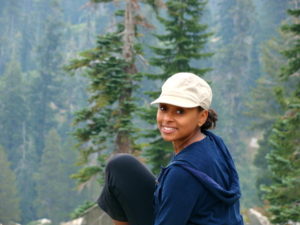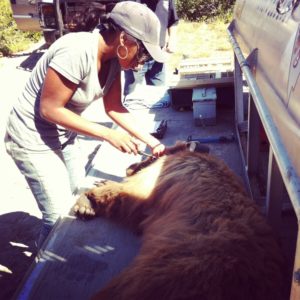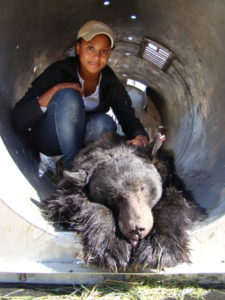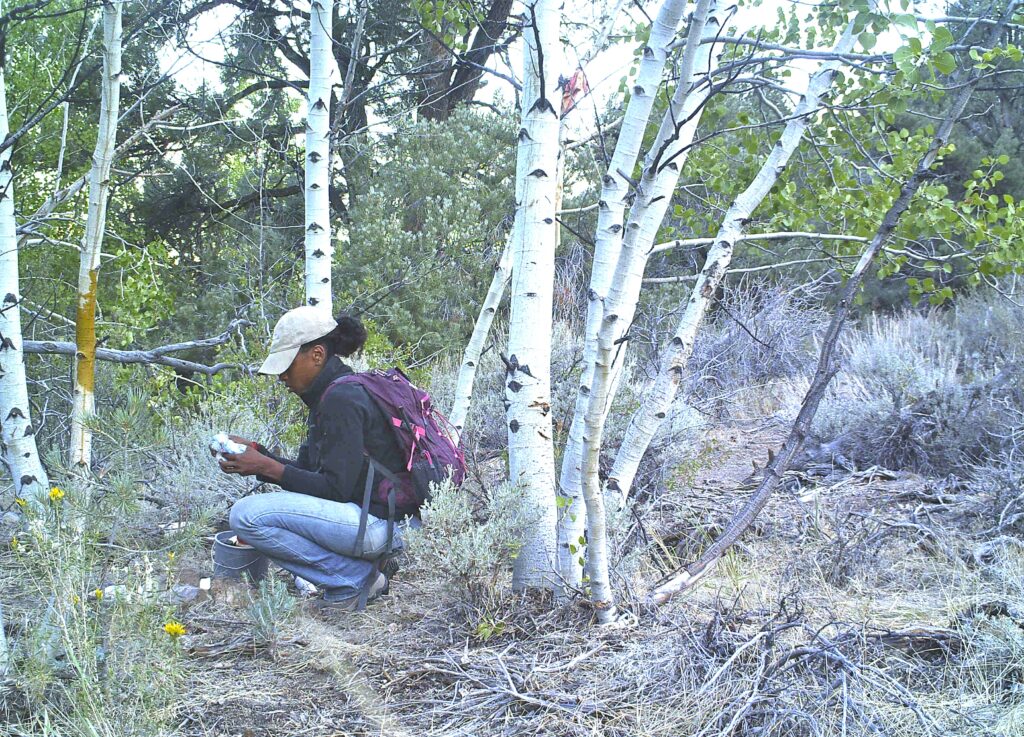
Conservation Ecologist Rae Wynn-Grant studies carnivores. She traps bears in order to learn about them. Then she releases them back into the wild.
What’s the most dangerous animal you have seen? Where did you see it?

“I’ll never forget getting picked up from the airport in Nairobi.” On the way to the campsite, “we saw giraffes and zebras … moments after landing. It was just amazing and I thought ‘How could you ever leave here?'”
Conservation Biologist Rae Wynn-Grant was a college student at Emory University when she participated in a wildlife management study abroad program in Kenya. Camping for the first time, “observing wildlife and studying them, I realized that this was the area that I would love to hone in on. The environment is vast and I thought that large mammals, large carnivores were what I was really interested in.” “Some people are not cut out for field work, but I just ate it up.”
Wynn-Grant and the rest of the team used estimation and simple counting skills to help determine how many animals there were in each species in the areas of Kenya where they traveled. They counted large animals, such as elephants, wildebeests, and zebras, including the Grevy’s zebra, an endangered species. And because African wild dogs had almost been hunted to extinction, they paid particular attention to the numbers of pups they found.

Human beings often find themselves in conflict with other animals. We hunt them for food and for sport and sometimes they come after our food, garbage, or pets. Wynn-Grant finds these conflicts interesting and works to help find solutions to make peace between our species and other carnivores. Most recently, she has focused her attention on black bears.
Until a few years ago, Wynn-Grant had never seen a bear. She studied African lions. But lions were difficult to pursue in New York, where she was in graduate school at Columbia University. The different lion prides were all being studied but no one at Columbia focused on that work. So when one of her advisors introduced her to a colleague doing research on the black bears of California and Nevada’s Lake Tahoe Basin, she leaped at the opportunity to join that field work and help analyze the data scientists were collecting. Wynn-Grant flew out to Lake Tahoe “and started catching bears.”
How do they catch the bears? Wynn-Grant and her colleagues set foot snares, a relatively gentle kind of trap. “We dig a hole into the ground and put some yummy food at the bottom of the hole.” What do bears like to eat? “Peanut butter, sardines, or marshmallows: very sweet or very smoky, fragrant food.” “Surrounding the hole is a snare, which is a thick wire with a spring that clasps the bear’s arm. We don’t always have great luck because these are fairly humane snares. They are not super tight on the bear’s paw so sometimes they just slide out. But when we are lucky, the bear is trapped, connected to a nearby tree so he can move around a few meters’ radius from the tree.” Then the scientists tranquilize the bear, making it sleep just long enough for them to put a collar on it and take a few measurements.

In the Lake Tahoe Basin, data suggests that most bears don’t die of illness or old age: usually they die when they encounter human beings. Although black bears do not usually kill people they cross paths with, they are often killed for wandering onto people’s property.
One goal of the work the Lake Tahoe team does is to put GPS collars on as many bears as possible. This allows them to track them, to figure out where they spend their time. “Bears spend a lot of time traveling.” Some scientists study the angles of the paths they take as they move from place to place.
Large mammals have home ranges, or territories, which are especially important for solitary animals like black bears. Wynn-Grant looks at changes in those home ranges. When the data she and her colleagues collect indicates a shift in a bear’s home range, she investigates the reasons for that shift. Have humans caused the bear to move or were there natural changes in its environment? She’s finding that “different patterns of human influence on the landscape are highly influential on bear movement.” When more people drive on roads, build houses, or spend time on outdoor sports like skiing and hiking, bears end up searching for new places to live. And, Wynn-Grant discovered, our activities affect bears’ habitats more than do natural variations in the land, which might be forest, grassy areas, or farmland.
Wynn-Grant hopes that her work will change the way ecologists and government officials map the areas where bears and other large carnivores live. These maps should include more detailed information about human activities likely to influence the bears’ movement. Understanding what makes these large carnivores move their home ranges should help governments make laws that will better protect bears and human beings from each other. “Science and government often support each other. I know that the maps I create will go to the Nevada Department of Wildlife.”

The only television shows Rae could watch as a child were on PBS, the Public Broadcasting Service. “I used to love the nature shows and by love, I mean I was just obsessed.” She dreamed of hosting a nature show, of being “the on-camera person who would pick up a lizard” and tell the people watching what type of lizard it is and where it lives. But the hosts of the shows she watched “were older white British men and I remember thinking ‘oh, you have to be that kind of person to have that kind of career.'” Nonetheless, Rae generally did well in her science classes and enjoyed science even when she didn’t get top grades.
When she arrived at Emory, Wynn-Grant stopped by the environmental science table at a fair promoting the different subjects students could choose for their majors. “There was one black professor there and he called me over, talked with me for a second, and said ‘I think you would really enjoy environmental science. You should think about being an environmental science major’ and he seemed so sure about it. And I said ‘ok, great’ and that was that. That man changed my whole trajectory.”



